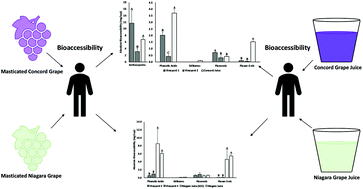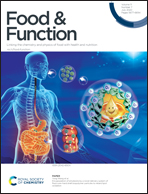Comparative assessment of phenolic bioaccessibility from 100% grape juice and whole grapes†
Abstract
Juicing of grapes includes contact with phenolic rich seeds and skins that otherwise rely on maceration for phenolic release. To understand if 100% grape juice can provide a matrix with highly bioaccessible phenolics relative to whole fruit, differences in phenolic content and bioaccessibility from commonly consumed table, Concord (CG) and Niagara (NG) grapes and their 100% juices were compared. Phenolic contents in whole grapes and 100% juices were assayed by LC-MS prior to in vitro digestion to determine phenolic bioaccessibility. Phenolic compounds were concentrated in CG and NG seeds as flavan-3-ols (222.2–285.5 mg per 100 g fw). CG skins were rich in anthocyanins (201.4 mg per 100 g fw) and flavonols (15.5 mg per 100 g fw). Product form had a significant impact on content (p < 0.01), relative bioaccessibility, and absolute bioaccessibility (p < 0.01). CG had a higher total phenolic content (21.9–50.7 mg per 100 g fw) compared to CGJ (5.8 mg per 100 g fw), though NG (4.9–10.8 mg per 100 g fw) was similar in phenolic content to NGJ (9.4–10.8 mg per 100 g fw). Absolute bioaccessibility of total phenolics from CGJ (5.2 mg per 100 g fw) was similar to CG (2.6–9.6 mg per 100 g fw), while NGJ (5.1–5.7 mg per 100 g fw) had higher bioaccessible phenolic content than NG (0.8–1.1 mg per 100 g fw). Differences in bioaccessible content were driven by high relative bioaccessibility of anthocyanins in CGJ (86–135%) compared to CG (14–39%) as well as for flavan-3-ols and phenolic acids from CGJ/NGJ (48–101; 39–85%) compared to CG/NG (0–3; 9–67%). Comparisons between juices and table grapes followed similar trends. A greater fraction of skin and seed phenolics was extracted through juicing and made bioaccessible, making 100% grape juice and whole fruit similar in phenolic delivery to consumers.



 Please wait while we load your content...
Please wait while we load your content...